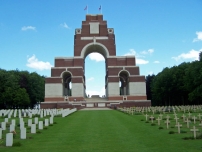| First Name: | Edward Francis | Last Name: | SKINNER | |
|---|---|---|---|---|
| Date of Death: | 19/10/1916 | Lived/Born In: | Limehouse | |
| Rank: | Rifleman | Unit: | Rifle Brigade1 | |
| Memorial Site: | 1. Limehouse, St Anne 2. Thiepval Memorial | |||
Current Information:Born-Limehouse
The Battle of the Somme (July-November, 1916) By the beginning of October, 1916, the Battle of the Somme had been raging for three months. Thousands of men had already been killed or wounded or were simply missing, never to be seen again and and just a few square miles of the French countryside, nearly all in the southern part of the battlefield, had been captured from the enemy. Mistakes had been made by the various commanders and would be continued to be made but there was no turning back as the British, Australians, South Africans, New Zealanders and Canadians carried on battering away at the German defences in the hope of a breakthrough, So it continued all the way through to November with nearly every battalion and division then in France being drawn into it at some stage. In the end the German trenches had been pushed back a few more miles along most of the line but the cost in lives had been staggering. By the end of the fighting in November, 1916, British Army casualties numbered over 400,000, killed, wounded and missing. On 1st October, 1916, a new offensive was begun by the British Army. The Battle of Transloy Ridge was the last major operation fought during the battle of the Somme and it continued throughout the first three weeks of the month until the terrible conditions of rain, mud and cold coupled with the sheer exhaustion of the troops, brought things to a standstill. The aim had been to push the enemy further back to the next ridge of higher ground running between Le Transloy and Warlencourt. It was a very hard fight, progress was painfully slow, the casualty figure was shockingly high and the final objective was not achieved despite the best efforts of the attacking divisions. Three factors worked against its success. The first was the weather. It was simply awful. The second was the miles of war torn terrain which soon became a quagmire over which troops, guns, ammunition and all the other supplies had to cross to reach the front and keep the momentum of the offensive going. For the Germans, falling back on their own supply lines across relatively unscathed ground, this was not such a problem. The third factor was the new methods of defence employed by the enemy. They defended in depth without a well defined front line but rather setting up machine-gun nests in shell holes and other strategically important sites where just a few men could hold up an entire battalion. And of course, the German artillery had the whole area covered. Just after a week into the battle, 4th Division took over the extreme right of the British line, next to the French. 11 Brigade remained in reserve at Montauban until 16th October when they moved up ready to join in an attack two days later. On the night of 17th October, in the pouring rain, they took up position east of Lesboeufs on the northern slopes of the Morval ridge, astride the Morval-Le Transloy road, though by this stage no trace remained of this country lane. At 3.40am on 18th October, 1st Rifle Brigade and 1st East Lancashire of 11 Brigade attacked. The plan was for 4th Division to contain the enemy on their front while the French continued making gains on their right. Their objective was the capture of parts of Rainbow, Dewdrop, Frosty and Hazy Trenches which meant an advance of 300-500 yards. But things did not work out as planned. The accompanying tank got stuck in a sunken road and played no part in the fight. Everything became very confused in the dark and the rain and German resistance was strong. Some of 1st Rifle Brigade managed to reach the gun pits in front of Hazy Trench but eventually all the surviving attackers were withdrawn to their own front line. Many of the 250 casualties sustained by 1st Rifle Brigade during this unsuccessful attack, including Edward Skinner, are shown as being on the following day, 19th October, when they were relieved from their forward positions. The most likely explanation for this is that in the confusion of battle, their deaths were not recorded until then. |
||||
| « Back to Search Results | ||||
| If you think any of the information shown here is incorrect, Click Here to submit your amends and comments | ||||




